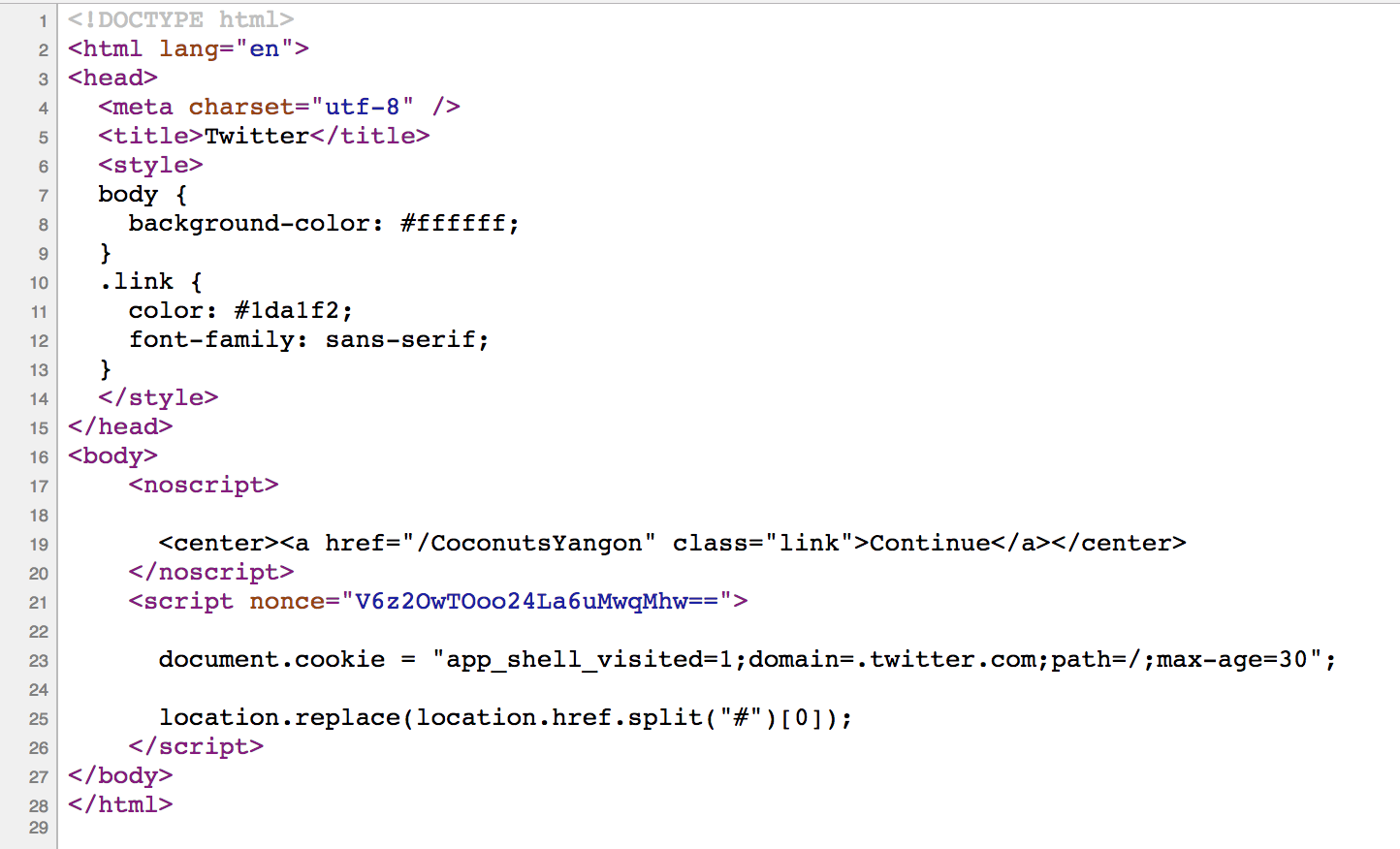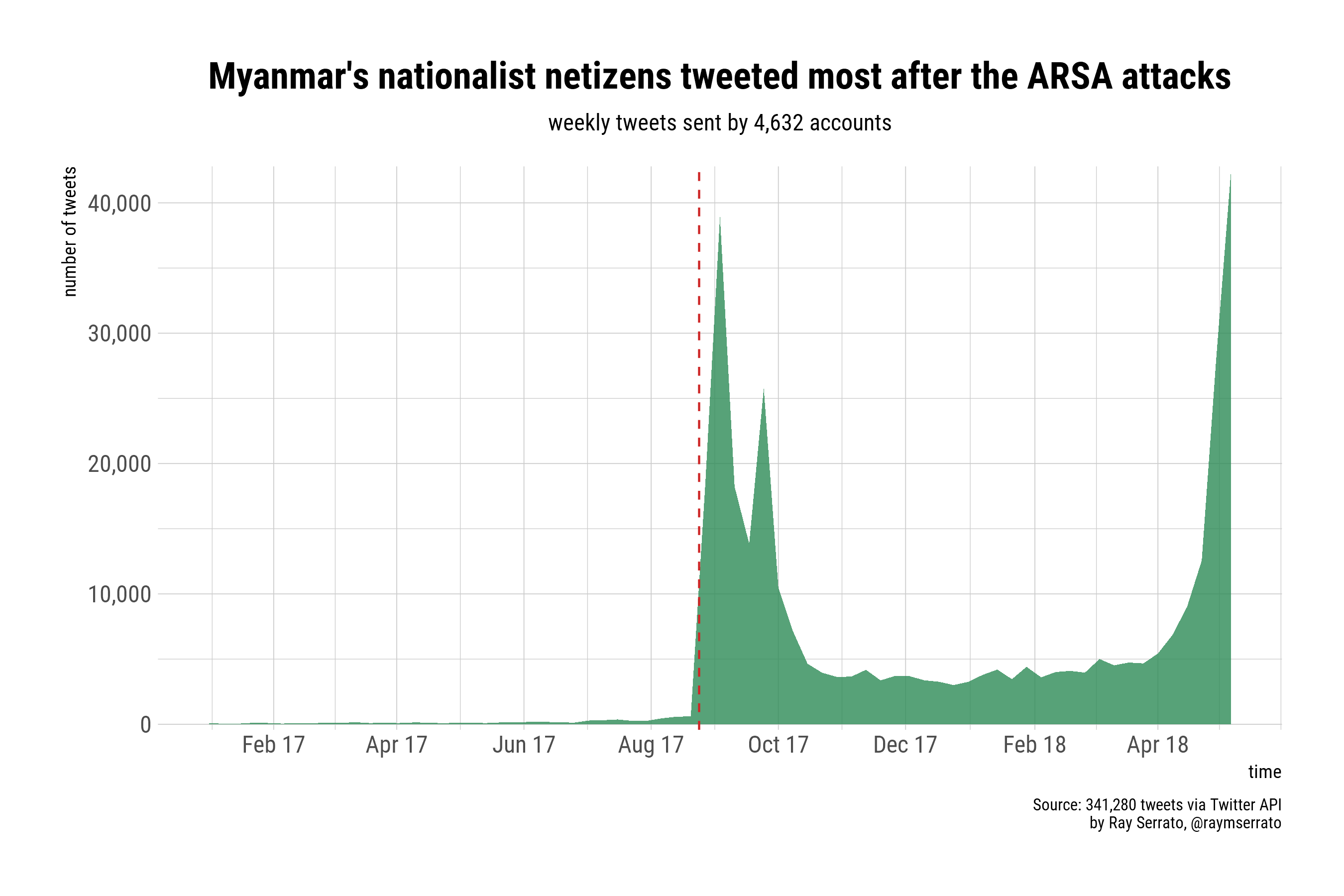Twitter hid its source code from public view days after the code was cited as evidence of automation among some of the bot-like accounts that suddenly came into existence last month, during a phenomenon dubbed “botmageddon” by users who were affected by it.
The mysterious Twitter accounts followed prominent Southeast Asia-based users by the thousands, arousing skepticism about the company’s recent pledge to eliminate spam and prompting calls for greater transparency from the company, which continues to claim that the accounts belong to real people, despite their bot-like qualities.
In Myanmar, specifically, the appearance of the accounts sparked fears that they could be weaponized by ultranationalist, anti-Rohingya handlers – fears that appear to have been borne out by recent developments.
READ: Why is Twitter silent on the mysterious Southeast Asian ‘bot’ following?
One of the bot-like qualities among the accounts was a pattern of identical timestamps in their source code, indicating that a number of accounts tweeted at the exact same time. The pattern was first identified by California-based social entrepreneur Maya Gilliss-Chapman, who said it was evidence of automation.
Ray Serrato, a Berlin-based digital analyst who has been monitoring the bot-like accounts, agreed. “The matching timestamps are a strong indication of automation, particularly if the tweets are the same,” he told Coconuts recently.
However, when Coconuts asked a Twitter spokesperson on April 23 whether identical timestamps among three bot-like accounts indicated automation, the spokesperson declined to comment, citing “privacy and security reasons.”



But Twitter did not just ignore the evidence of automation; the company quietly proceeded to make the evidence harder to see. When Gilliss-Chapman first accessed the source code, all she – or anyone – had to do was right-click any Twitter webpage and select “View Page Source.” This would yield hundreds of lines of code containing a detailed history of the account’s activity, including timestamps.
But sometime between April 23 and May 4, the vast majority of the source code disappeared from public view. It was reduced from hundreds of lines to just 29 lines per account. Timestamps were among the content that disappeared.
When asked this week why the source code was concealed and whether its concealment was an indication that its previous visibility had been a security threat to users, the same Twitter spokesperson declined to comment.

To be sure, it is still possible to view a Twitter account’s source code. One way is to use the Developer Tools in your browser (right-click a Twitter page and select “Inspect”). This appears to produce the same source code that was previously available, though in a less attractive format. Another way is to unlock access to Twitter’s application programming interface (API) using an external application after installing additional coding language and software.
But even though it’s still accessible by these roundabout means, Twitter’s silent adjustment of its source code’s accessibility around the same time that users across Southeast Asia were calling for greater transparency appears to validate those users’ concerns.
Gilliss-Chapman said: “I’m surprised Twitter chose not to comment on the source code topic because it was a great opportunity for them to be transparent. If they did intentionally make the source code harder to find, they definitely went out of their way to do it. It would be interesting to hear the reason as to why and why it became a priority. If connected, it would also be interesting to hear what other actions they plan to take in response to this uptick in bots.”
READ: Evidence of automation raises additional questions in Twitter ‘bot’ surge
As Gilliss-Chapman points out, botmageddon is not over. The mysterious accounts that came into being last month still exist, and they are starting to grow more active, raising new suspicions about their provenance. One such suspicion is that the accounts – at least those in Myanmar – are related to a movement that supports the military’s mass displacement of the Rohingya.
Serrato, the analyst, has found that there are links between bot-like accounts that appeared around the time the mass displacement began in Aug. 2017 and accounts that appeared last month. He also found that the volume of tweets among these bot-like accounts and their followers peaked in both Aug. 2017 and in April 2018.
 “There are basically two scenarios here, in my view,” he told Coconuts. “[Either] a bot merchant created fake accounts region-wide and has started selling them for use, and some anti-Rohingya elements are using some of those accounts; [or] they are genuine accounts of new nationalists on Twitter, and they want to revive the toxic narratives from Aug. 2017.”
“There are basically two scenarios here, in my view,” he told Coconuts. “[Either] a bot merchant created fake accounts region-wide and has started selling them for use, and some anti-Rohingya elements are using some of those accounts; [or] they are genuine accounts of new nationalists on Twitter, and they want to revive the toxic narratives from Aug. 2017.”
Either way, Twitter’s refusal to acknowledge the bot-like patterns guiding these accounts is the opposite of the transparency users want to see.
Gilliss-Chapman said: “We’ll see if Twitter steps up and addresses these concerns, but it’s really up to them how transparent they choose to be with their users and how accountable they choose to hold themselves.”



Reader Interactions